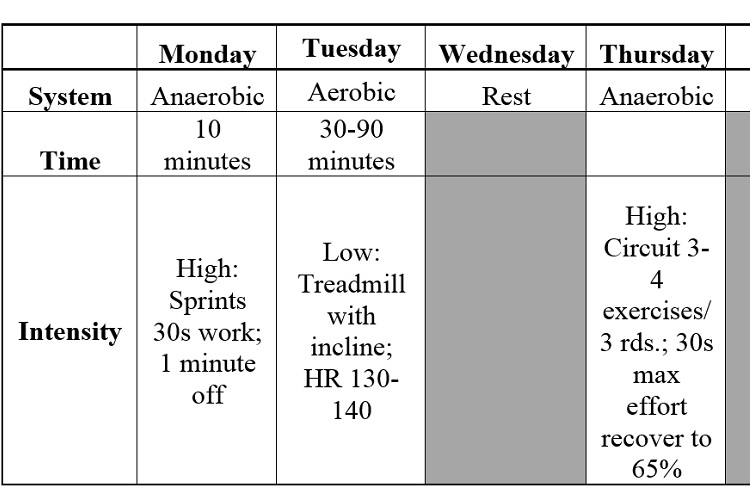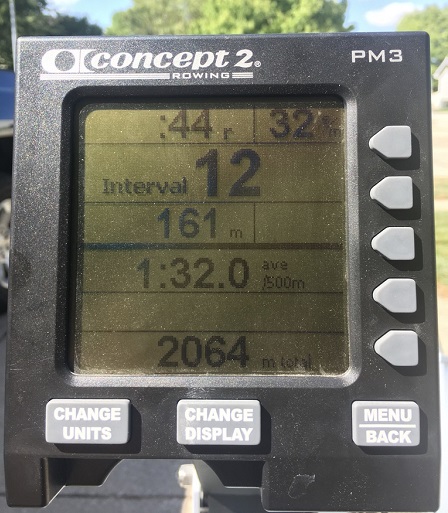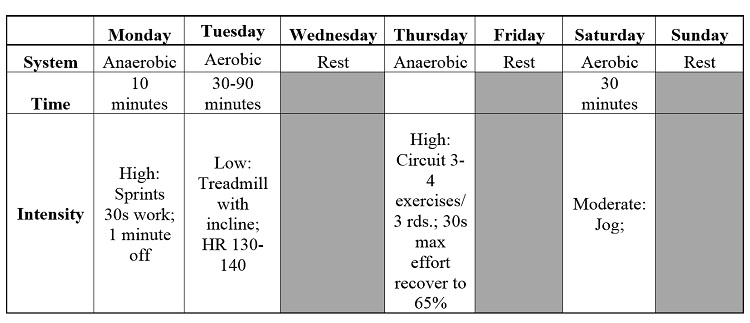
By Ty Wheeler
For Part 1 of this series, click HERE
For Part 2 of this series, click HERE
As we continue through our tactical fitness series, this article will focus on conditioning. This is one area of fitness where many misconceptions delineate and the individuals looking to improve health automatically turn to as the avenue for improved fitness.
Running on a treadmill for days on end—which has been a mainstay in the fire service as well as general population—to lose weight to become “healthier.” Although running can have significant health benefits, it also has some major drawbacks. If you are an avid runner, I would encourage you to continue to do so, but you should also incorporate other training methods as well. As we all know, firefighting is a very strenuous profession, so many times firefighters will jump on the “rabbit wheel” (the treadmill) to improve cardiorespiratory fitness. But as we discussed, we need to be functional and specific when programming for our tactical populations.
What is conditioning? Joel Jamieson states, “Conditioning is a measure of how well an athlete is able to meet the energy production demands of their sport.”1
Conditioning is much more complex than you may realize; to train with these complex systems, it often takes a lot of understanding of physiology. There are many different methods for performing conditioning, depending on your end goal. We can break up conditioning into “aerobic” and “anaerobic” conditioning, each having multiple methods for programming.

Aerobic Conditioning
Aerobic conditioning uses oxygen to produce energy. Often, we associate aerobic conditioning to long-distance running, but this does not need to be the case. We can also use methods such as cardiac power interval, tempo method, and high-resistance interval, to name a few. National Strength and Conditioning Association (NSCA) Essentials for Tactical Strength and Conditioning states, “Aerobic endurance… reduces their risk of cardiovascular disease and improve their ability to execute tactical tasks without undue fatigue.”2 This is vitally important for firefighters, as one of our most significant LODDs is related to cardiovascular compromise.
To perform aerobic training, it is best to have a heart rate monitor during your workouts to precisely stay within the aerobic threshold.
Anaerobic Conditioning
Anaerobic systems use energy without oxygen, so the duration will be shorter. For this type of training we will focus on interval training with maximum power and maximum intensity with short durations. The training methods used in this system include sprinting, rowing, or biking for traditional intervals. We can also use weight resistance exercises performed for as timed or set number of repetitions. These can include—but are not limited to—barbells, kettlebells, tires, battle ropes, and so on.
Specificity
No matter the type of training you favor or choose to perform, it is important that you train both aerobic and anaerobic systems to develop a well-rounded tactical athlete. To ensure your training is directly benefiting your abilities to perform tasks—either on the fireground or in the streets—they need to be transferable.
I discussed specificity and specific physical preparedness (SPP) in our last article, but it also translates to our aerobic and anaerobic systems as well. We need to evaluate what type of conditioning training is going to be the best for each individual tactical athlete. A firefighter will require short bursts of a few minutes of high-intensity capacity, rest, and repeat. For example, soldiers on the battlefield will need long-distance endurance with heavy weight for rucks.
The SAID (specific adaptations to imposed demands) Principle also applies for occupational specificity. A structural firefighter does not need to ruck 13 miles carry 100 pounds of equipment; our training needs to simulate the environment and tasks we will face while down range or on fireground. Firefighting encompasses high intensity with short rest periods while performing strength based tasks. We need to use similar training, so implementing circuit training with resistance equipment will be specific to our profession.
RELATED: Krueger on Personal Fitness Style ‖ Ponder: How Are Your Hips? ‖ Kerrigan and Moss on the Four Fundamentals of Firefighter Functional Fitness
Conditioning Programming for the Tactical Athlete
To make significant improvements, we need to ensure that we are training all types of conditioning and varying the intensities, duration, and type of exercise. To build overall tactical conditioning we need to also train both aerobic and anaerobic conditioning.
The chart below is an example of a week-long program that focuses on both systems. Here, we have a four-day program that uses high-intensity sprint intervals and 30 seconds of work followed by one minute of rest. After each week, you should begin to reduce the rest periods (1 minute, 45 seconds, 30 seconds, and so on).
FIGURE 1. Week-Long Aerobic and Anaerobic Conditioning Program

The second day is focused on aerobic capacity at a long, slow distance method. This will be 30-90 minutes of moderate-paced walking with the option for incline. It is best to use a heart rate monitor to measure your heart rate, which should be maintained between 130-150 beats per minute.
After the day of rest, conduct an anaerobic day of high-intensity circuit training that focuses on strength development with a power interval method. The last day will consist of a moderate jog lasting 30 minutes. In this four-day program, we focus on four different conditioning methods between the two systems to develop overall tactical conditioning.

Evaluations
The final step to conditioning is evaluations and reevaluations. To ensure that you are improving, take an evaluation test to show progress in your conditioning. There are several methods to do so, but I will only discuss two here. First is a VO2Max test; this will give you scientific data to compare your VO2max with your predetermined improvements. The second is a Cooper’s Test. This is a much easier test. Here, you perform a run for max distance in six minutes.
These are good ways to see if you are improving and progressing. There will come a time when your body will become less adaptive to the program. In those instances, it will require the development of new program or training stimuli to create those adaptive
Conditioning is essential for the tactical athlete; it is a significant indicator of the operator’s ability perform tasks on the fireground. It also serves firefighters even greater because of their risk for cardiovascular compromise. This foundation of tactical fitness is essential to our success, but it is often surrounded with many misconceptions and misnomers.
This brief overview of conditioning is an example of the methods you can use to improve your conditioning. To learn more, read Joel Jamieson’s Ultimate MMA Conditioning. This publication is a detailed manual of conditioning that you can apply to any sport and which covers aerobic and anaerobic systems in great depth backed by personal experience and proven scientific methods.
Ty Wheeler is a nine-year fire service veteran and a firefighter/paramedic with Johnston-Grimes (IA) Metropolitan Fire Department. He has an associate degree in paramedicine and a bachelor’s degree in fire science administration from Waldorf University. Wheeler has received several fire service and emergency medical services certifications throughout his fire service career at the state and national level. He is a member of the Iowa Society of Fire Service Instructors and with the National Strength and Conditioning Association (NSCA). Wheeler is also a certified strength and conditioning coach through the NSCA. He also teaches for the Iowa Fire Service Training Bureau and will soon serve as the Iowa Director of the Firefighter Cancer Support Network.

